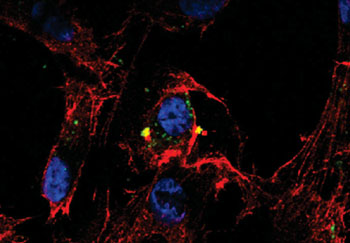Connecting Molecular Dots of the Association Between Periodontitis and Heart Disease
By LabMedica International staff writers
Posted on 28 Sep 2015
Periodontitis is a risk factor for heart disease. Researchers have now shown that a periodontal pathogen causes changes in gene expression that boost inflammation and atherosclerosis in aortic smooth muscle cells. Posted on 28 Sep 2015
The circumstantial evidence that led to this study was ample. The periodontal pathogen Porphyromonas gingivalis had also been found in coronary artery plaques of heart attack patients. And in two species of animal models, P. gingivalis was shown to cause and accelerate formation of coronary and aortic atherosclerosis. Investigators led by Torbjörn Bengtsson, School of Health Sciences, Örebro University (Örebro, Sweden), have now discovered how this happens.

Image: Confocal fluorosence microscopy of human aortic smooth muscle cells infected with the periodontal pathogen P. gingivalis (Photo courtesy of Zhang B et al., 2015, and the journal Infection and Immunity).
They began by infecting cultured human aortic smooth muscle cells with P. gingivalis and found that gingipains (P. gingivalis virulence factors) boost expression of the pro-inflammatory angiopoietin 2, while dampening expression of the anti-inflammatory angiopoietin 1, with the net effect of increasing inflammation. “Although unstimulated [aortic smooth muscle cells] produce angiopoietin 2 at a low level, stimulation with wild-type P. gingivalis dramatically increases the gene expression of angiopoietin 2,” the investigators wrote.
“Angiopoietin 2 directly increases the migration of aortic smooth muscle cells,” said first author Boxi Zhang, PhD student, Prof. Bengtsson’s laboratory. “The migration of smooth muscle cells is involved in the pathogenesis of atherosclerosis.” As with ginginpains, tumor necrosis factor (TNF), the human-produced inflammatory cytokine and cardiovascular risk factor, also induces and promotes atherosclerosis via the two angiopoietins. However, their research showed that ginginpains operate independently from TNF.
“Our research clarifies the mechanism behind the association of periodontitis and cardiovascular disease,” said B. Zhang, “Our aim is to find biomarkers that can help us diagnose and treat both diseases.”
The study, by Zhang B et al., was published online ahead of print August 17, 2015, in the journal Infection and Immunity.
Related Links:
Örebro University













